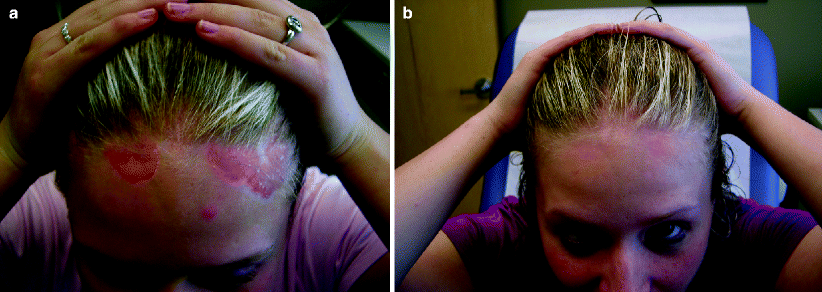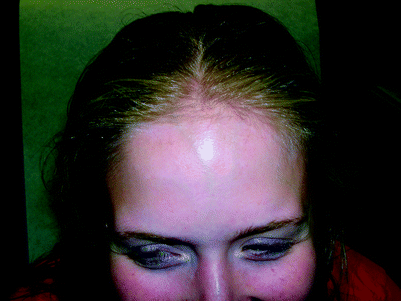Excimer Lasers
Psoriasis
Vitiligo
Other forms of Hypopigmentation
Indications and Contraindications
Psoriasis
Vitiligo
Techniques
Psoriasis
Vitiligo
Adverse Events
Future Directions
Conclusion
References
Introduction
Psoriasis and vitiligo have been found to benefit from light therapy in the UVB range (290–320 nm). The 308 nm xenon-chloride excimer laser is now utilized for select patients with psoriasis and vitiligo. The efficacy and safety of the excimer laser is well documented. Striae and post-resurfacing leucoderma have been found to respond to the 308 nm excimer laser. |
One of the most recent advancements in phototherapy is the development of localized delivery systems. One such device is the excimer laser. The use of the excimer laser was first reported in dermatology by Bonis in 1997 for psoriasis treatment.1 Psoriasis has been reported to respond best to light at a wavelength of 313 nm.2 Since the excimer laser emits light at a wavelength of 308 nm, it was a logical choice for investigation. The excimer laser has been found to be efficacious for not only patients suffering from psoriasis but also several disorders of hypopigmentation including vitiligo. This chapter serves to discuss the use of the excimer laser for psoriasis and diseases of hypopigmentation.
Excimer lasers are a group of lasers utilized in a variety of medical specialties, most notably ophthalmology. There are several types of excimer lasers, all of which operate in the ultraviolet spectrum. Excimer refers to the formation of “excited dimers” via an inducible mixture of a halogen and noble gas. Electric current is delivered to the gas producing unstable, high-energy dimers that quickly dissociate giving off laser light.3 The laser light is delivered to its target via a fiber optic cable. The mechanism of physiologic response is poorly understood, but does not appear to be a thermal mechanism. Thus, the excimer lasers do not operate under the theory of selective photothermolysis. Excimer lasers are capable of “cold ablation,” which is precise tissue ablation with minimal surrounding thermal effects. This unique property enables the laser to be used in precision surgeries such as corneal reshaping. It is theorized that the energy of the photons from excimer lasers exceeds the energy of many chemical bonds which keep organic material together. This principle forms the theory termed “ablative decomposition,” under which excimer lasers are thought to operate.
Excimer Lasers
Psoriasis
Total cumulative dose is lower than traditional light therapy. Uninvolved skin is spared. Psoriatic plaques can tolerate several times the minimal erythema dose (MED). |
The benefits of using the 308 nm excimer laser for psoriasis were fully elucidated in the late 1990s. Bonis showed that psoriatic lesions treated with the excimer laser cleared with fewer treatments than narrow band UVB therapy.1 Utilization of the laser also spared the uninvolved skin from UV exposure, reducing the risk of carcinogenicity and photoaging. Kemeny also found that remissions for up to 2 years were seen in some patients.4 Laser therapy demonstrated efficacy at lower cumulative doses when compared to conventional light therapy. It was also noted that psoriatic plaques can tolerate several times the minimal erythema dose (MED) of normal skin without burning. Exposure of three to four times the MED have demonstrated early clearance and long remissions. Doses greater than six times the MED, however, have shown to be complicated by blistering, pain and reduced compliance. In 2002, Feldman reported 80 patients treated with lower multipliers of the MED given twice weekly achieved 75% or greater clearance in 72% of subjects in an average of 6.2 treatments.5
The pulse dye laser (PDL) has also been studied for the treatment of psoriasis. The basis for using the PDL is selective photothermolysis of the exaggerated vascular network within psoriatic plaques. Small studies have revealed possible benefit.6–8 Stronger data exists to support the use of the 308 nm excimer laser for the treatment of psoriasis.5
Vitiligo
The excimer laser is as effective as oral PUVA, but with less associated risk. Over 25% of treated patients achieve 100% repigmentation. |
The 308 nm excimer laser has also been shown to treat hypopigmentation of various etiologies. Vitiligo, which affects 1–2% of the population, is well known to be recalcitrant to most medical therapies. The disease has been treated with multiple forms of light therapy however, treatment requires many months of therapy exposing large areas of unaffected skin to ultraviolet radiation. Therapy is aimed at stimulating adjacent melanocytes to migrate and repopulate the affected skin. The use of the excimer laser for vitiligo was based on the finding that narrowband UVB therapy was as effective as oral PUVA with less associated risk. Hadi et al. demonstrated 50.6% of 221 vitiligo patients had 75% or greater repigmentation after an average of 23 sessions. Also noteworthy is the fact that 25.5% of the patients achieved 100% repigmentation of the treated lesions. Two year follow-up did not reveal any loss of new pigmentation. Some patients even had continued repigmentation after treatment was completed.9 These studies support the notion that the excimer laser works as well as NBUVB or PUVA for vitiligo, but in much less time. Kawalek et al. showed that the addition of tacrolimus 0.1% ointment in combination with the excimer laser induced faster and perhaps greater response to treatment.10
Other Forms of Hypopigmentation: Post-resurfacing Leucoderma and Striae
Striae and post-resurfacing leucoderma can be safely treated with the excimer laser, although the results are not sustained. Striae associated atrophy remains unchanged after therapy. |
Leucoderma is a generic term defined as, “deficiency of pigmentation of the skin.”11 Some authors have used this term more specifically to describe post-resurfacing hypopigmenation.12 These hypopigmented macules and patches are known complications of carbon dioxide laser resurfacing. In 2001, Friedman and Geronemus reported using the 308 nm excimer laser for post carbon dioxide resurfacing leucoderma.12 Two patients demonstrated 50–75% improvement with 8–10 treatments.
This therapy stimulates residual melanocytes while limiting cumulative UV-B exposure. Alexiades-Armenakas et al. in 2004 studied the response of hypopigmented scars, including striae alba, to the excimer laser. Thirty-one patients received up to ten treatments starting at 1 MED minus 50 mJ/cm2. Visual analysis found 61% and 68% increase in pigmentation for leucoderma and striae, respectively, compared to control after nine treatments. However, the treated areas slowly depigmented back to baseline within 6 months of treatment cessation.13
In addition, Goldberg demonstrated 76% or greater darkening of striae after an average of eight treatments.14 However, atrophy remained unchanged and the pigmentary improvements were not sustained. For patients with mature hypopigmented striae and hypopigmented scars, the 308 nm excimer laser presents a safe option for a common cosmetic concern with few other effective treatments.
Indications and Contraindications
Psoriasis
Indications Localized plaques that have not responded to medical therapy. Mild to moderate psoriasis. Contraindications Patients that report worsening of their lesions upon light exposure. |
The excimer laser is indicated for mild to moderate psoriasis. Psoriatic lesions that occur in the groin and axilla (inverse psoriasis) respond well to the excimer laser. These areas are notoriously difficult to treat with traditional NBUVB. The excimer laser also works well for recalcitrant psoriatic lesions in areas such as the scalp. The most difficult areas to treat are the palms and soles. The excimer laser may also be used in conjunction with other systemic treatments for recalcitrant lesions. The excimer laser may be used in all skin types, however, skin types II, III, and IV appear to respond the best. Very fair skin may burn more easily and care must be taken when treating these patients. The only true contraindication is the rare psoriatic patient that reports worsening of lesions upon exposure to light.
A suitable patient is one who is able to commit to multiple treatments per week for potentially several weeks. Thus, compliance is usually the limiting factor for improvement. Increasing insurance copayments is also a substantial obstacle. Insurance coverage varies and documentation of prior treatment failure is usually required for approval. The ideal candidate lives or works near the unit location, has skin type II–IV, and has disease limited to the scalp or flexural areas. Most importantly, the patient must be committed to the course of treatment (Figs. 1a, b and 2).



Fig. 1
(a) 21 y/o female with scalp psoriasis (b) after 12 treatments excimer laser

Fig. 2
One year follow up, still clear
Vitiligo
Indications Vitiligo with less than 20% involvement.
Stay updated, free articles. Join our Telegram channel
Full access? Get Clinical Tree
 Get Clinical Tree app for offline access
Get Clinical Tree app for offline access

|





